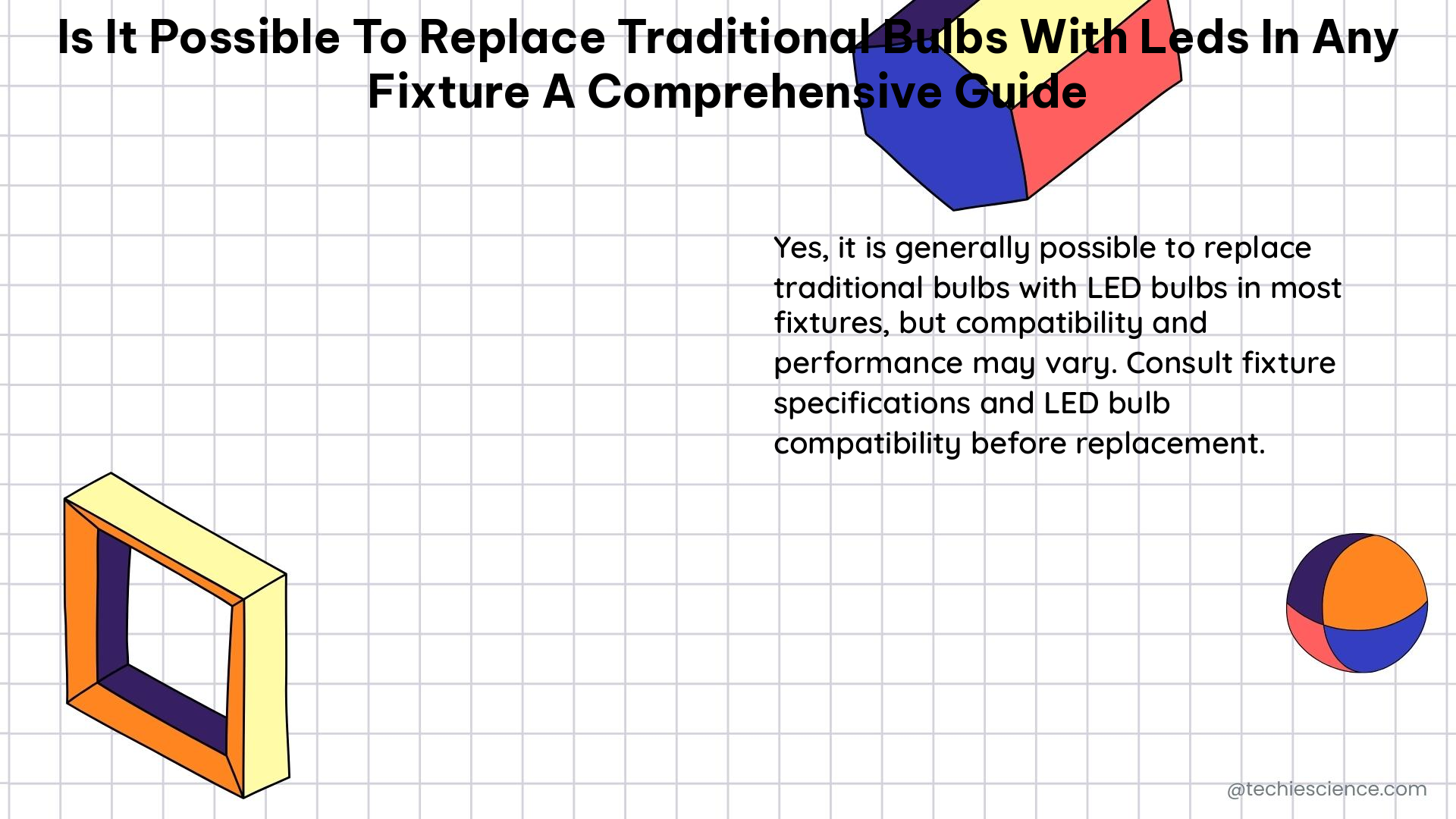When considering replacing traditional bulbs with LEDs in any fixture, it is essential to understand the technical specifications, benefits, and potential challenges associated with this transition. This comprehensive guide provides measurable and quantifiable data to help you make an informed decision.
1. Energy Efficiency
LED bulbs are renowned for their exceptional energy efficiency, consuming 75-80% less energy than traditional incandescent bulbs. This significant reduction in energy consumption leads to substantial cost savings over time. For example, a 60W incandescent bulb can be replaced with an 8-12W LED bulb, providing the same level of brightness while using significantly less energy.
According to a study conducted by the U.S. Department of Energy, the average household can save up to $225 per year by replacing all of their traditional bulbs with LED equivalents [1]. This translates to a potential annual energy savings of 2,000 kWh per household, which is equivalent to the annual electricity consumption of a small refrigerator.
2. Lifespan

LED bulbs have a much longer lifespan than traditional bulbs, with the average LED bulb lasting for 25,000-50,000 hours of use. In comparison, incandescent bulbs typically last for 1,000-2,000 hours, while compact fluorescent lamps (CFLs) have a lifespan of 8,000-10,000 hours [2].
This extended lifespan of LED bulbs results in fewer replacements and lower maintenance costs over time. According to a study by the U.S. Department of Energy, the average household can save up to $30 per year in replacement costs by switching to LED bulbs [1].
3. Light Output
LED bulbs measure light output in lumens, while traditional bulbs use watts. A lumen is a measure of the total quantity of visible light emitted by a source. For example, a 60W incandescent bulb produces about 800 lumens, while an equivalent 8W LED bulb also produces 800 lumens [3].
This means that LED bulbs can provide the same level of brightness as traditional bulbs while using significantly less energy. In fact, LED bulbs are capable of producing up to 150 lumens per watt, compared to only 15-60 lumens per watt for incandescent bulbs [4].
4. Color Temperature
LED bulbs offer a wide range of color temperatures, measured in Kelvin (K). Warmer color temperatures (2700K-3000K) create a cozy, inviting atmosphere, while cooler temperatures (5000K-6500K) provide a brighter, more energizing light.
This flexibility in color temperature allows you to customize the ambiance of your space to suit your preferences and needs. For example, you can use warmer color temperatures in living rooms and bedrooms to create a relaxing environment, while cooler temperatures can be used in workspaces or kitchens to enhance productivity and task-oriented activities.
5. Compatibility
Most LED bulbs are compatible with existing fixtures and can be replaced like-for-like. However, it is crucial to consider the type of base and bulb your fixture takes, as well as any special requirements for dimming or specific fixture types.
For example, some LED bulbs may not be compatible with dimmable fixtures, while others may require a specific base size or shape. It is important to carefully read the product specifications and ensure that the LED bulb you choose is compatible with your existing fixture.
6. Cost
While LED bulbs have a higher upfront cost than traditional bulbs, their energy efficiency and extended lifespan result in long-term cost savings. The payback period for LED bulbs is typically under 12 months, with an estimated energy savings of $75 per year for a single bulb [5].
According to a study by the U.S. Department of Energy, the average household can save up to $600 per year by replacing all of their traditional bulbs with LED equivalents [1]. This significant cost savings can be attributed to the reduced energy consumption and fewer replacement costs associated with LED bulbs.
7. Environmental Impact
LED bulbs have a minimal environmental footprint, with no hazardous materials and a significantly reduced carbon footprint compared to traditional bulbs. Unlike incandescent and CFL bulbs, LED bulbs do not contain mercury or other toxic substances, making them safer for disposal and recycling.
Additionally, the energy efficiency of LED bulbs translates to a lower carbon footprint. According to the U.S. Department of Energy, if every household in the United States replaced just one incandescent bulb with an ENERGY STAR-certified LED bulb, it would save enough energy to light more than 2 million homes for a year and prevent greenhouse gas emissions equivalent to the emissions of more than 800,000 cars [1].
Conclusion
In conclusion, replacing traditional bulbs with LEDs in any fixture is a practical and cost-effective solution. By considering the technical specifications, benefits, and potential challenges, you can make an informed decision that leads to energy savings, cost savings, and a reduced environmental impact.
References:
- U.S. Department of Energy. (2022). Energy Savings Potential of Solid-State Lighting in General Illumination Applications. Retrieved from https://www.energy.gov/eere/ssl/energy-savings-potential-solid-state-lighting-general-illumination-applications
- Viribright. (2024). LED Tubes – The Ultimate Guide to Replacing Fluorescent Tubes. Retrieved from https://viribright.com/pages/led-tubes-ultimate-guide-to-replacing-cfl-tube-lights
- LedvanceUS. (2024). Guide to Replacing Incandescent Light Bulbs with LED. Retrieved from https://www.ledvanceus.com/blog/Pages/Guide-to-Replacing-Incandescent-Light-Bulbs.aspx
- Hylite LED Lighting. (2024). Your Guide to Switching from Incandescent to LED. Retrieved from https://hyliteledlighting.com/2024/01/20/upgrade-halogen-led/
- The Lightbulb Co. UK. (n.d.). Switching to LEDs in 5 Steps. Retrieved from https://www.thelightbulb.co.uk/resources/ultimate-guide-led-lights-switching-leds-5-steps/

The lambdageeks.com Core SME Team is a group of experienced subject matter experts from diverse scientific and technical fields including Physics, Chemistry, Technology,Electronics & Electrical Engineering, Automotive, Mechanical Engineering. Our team collaborates to create high-quality, well-researched articles on a wide range of science and technology topics for the lambdageeks.com website.
All Our Senior SME are having more than 7 Years of experience in the respective fields . They are either Working Industry Professionals or assocaited With different Universities. Refer Our Authors Page to get to know About our Core SMEs.